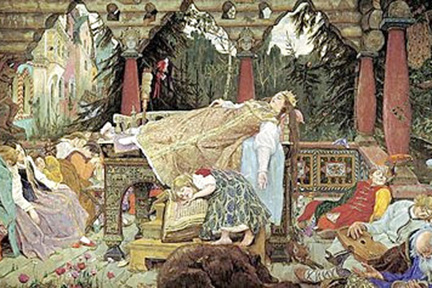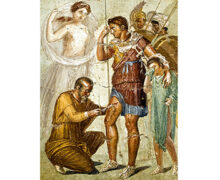
“La Bella Durmiente”
“Sleeping Beauty”
Un relato de violación y terror.
“Talía, Sol y Luna” es el nombre original del cuento que conocemos como “La Bella Durmiente”, escrito en el siglo XVII por el italiano Giambattista Basile, poeta, cortesano y cuentista, que llevo al papel muchos cuentos de hadas que circulaban por los pueblos del Reino de Nápoles, en forma oral, en el siglo XVII. Su obra más famosa de dos volúmenes fue “Il Pentamerone”, cuyo subtitulo “Lo cunto de li cunti” (El cuento de los cuentos) explicaba su contenido. El estilo utilizado es barroco metafórico. Realmente la obra fue publicada por su hermana, luego de su muerte, utilizando el seudónimo de Gian Alesio Abbatutis.
Luego estos libros llegaron a manos de Charles Perrault y los hermanos Grimm, quienes los adaptaron, legando a la posteridad títulos como Cenicienta, Hansel y Gretel, Rapunzel, El Gato con Botas y La Bella Durmiente.
La bella durmiente de Disney
El argumento de la película animada de Disney del año 1959 refiere a la princesa Aurora, que en su bautizo fue maldecida por el hada Maléfica, cayendo en un sueño profundo al cumplir 16 años y que solo podrá despertar con el beso del verdadero amor.
Así contada la historia es un canto al amor verdadero, pero en realidad el relato original, escrito por Giambattista Basile no es para niños ya que difiere mucho de la cándida película, pues es una historia de terror, que contiene violación y canibalismo.
Sol, Luna y Talía
Todo comienza cuando los profetas anuncian al Rey, padre de la princesa Talía, que su hija morirá a los 16 aniso, a consecuencia de pincharse con una astilla envenenada oculta entre telas de lino, por esta razón para proteger a su hija, decreta que el lino es un material prohibido dentro del palacio. Pero al llegar a la adolescencia Talía encuentra una rueca en los sótanos del castillo y se pincha con una astilla, cayendo en un sueño del que no logra despertar.
El Rey, destrozado por la supuesta muerte de su hija, decide colocar el cadáver, envuelto en terciopelo, en un cobertizo cerca del palacio, (hasta aquí todo es muy parecido a la película, diría usted, pero…). El relato continúa explicando que, al tiempo llega al lugar un cazador guiado por su halcón que, al entrar al cobertizo para refugiarse de la lluvia encuentra a la joven y hermosa princesa quien permanece en un profundo sueño, que al sentir que el cuerpo esta aun caliente decide abusar sexualmente de Talía, dejándola embarazada.
Pasado nueve meses la princesa da a luz a un par de gemelos, Sol y Luna, que logran sobrevivir bajo el cuidado de las hadas del bosque, quienes ayudaban a los niños a amamantarse de su madre dormida. Hasta que un día, el pequeño Sol succiona por error el dedo de su madre, extrayendo la astilla, sacando a su madre del profundo sueño, quien retorna con sus hijos al palacio.
Tiempo después, el cazador ingresa al castillo para vender el fruto de su trabajo, y encuentra a la joven en compañía de los dos niños, por supuesto el hombre busca reparar la situación pidiendo a la princesa en matrimonio, propuesta que ella acepta a pesar de haber sido violada, sin saber que él tenía otra esposa.
El matrimonio con la princesa parecía normal, ya que el salía por varios días al bosque, regresando con las piezas cazadas. Aunque en realidad mantenía una doble vida, conviviendo con sus dos esposas e hijos.
Su primera esposa descubre la farsa y decide secuestrar a Talía, Sol y Luna, ordenando al cocinero preparar un platillo con los pequeños, para luego devorarlos, y pide a su secretario quemar el cuerpo de Talía. Al regresar el hombre se entera de estas barbaridades, entonces ordena que su esposa, el secretario y el cocinero sean quemados vivos en la hoguera.
La historia concluye cuando el cocinero revela que no asesino a Talía ni a los pequeños, ya que había sustituido los supuestos cuerpos cocinados con carne de cabra. Al final y para lograr un final feliz, el noble y la princesa Talía se casan y viven felices con Sol y Luna.
Conclusión
Como vemos la historia es más del estilo de Stephen King que de un poeta del siglo XVII, pero recordemos que estas historias eran las contadas en los pueblos europeos, a la noche alrededor de una hoguera.
A story of rape and terror.
“Talía, Sol y Luna” is the original name of the story we know as “Sleeping Beauty”, written in the 17th century by the Italian Giambattista Basile, poet, courtier and storyteller, who put to paper many fairy tales that circulated around the world. the people of the Kingdom of Naples, in oral form, in the 17th century. His most famous two-volume work was “Il Pentamerone”, whose subtitle “Lo cunto de li cunti” (The tale of tales) explained its content. The style used is metaphorical baroque. The work was actually published by his sister, after his death, using the pseudonym Gian Alesio Abbatutis.
Later these books came into the hands of Charles Perrault and the Brothers Grimm, who adapted them, bequeathing to posterity titles such as Cinderella, Hansel and Gretel, Rapunzel, Puss in Boots and Sleeping Beauty.
Disney’s Sleeping Beauty
The plot of the 1959 Disney animated film refers to Princess Aurora, who at her baptism was cursed by the fairy Maleficent, falling into a deep sleep when she turned 16 and who can only wake up with true love’s kiss.
Told this way, the story is a hymn to true love, but in reality the original story, written by Giambattista Basile, is not for children since it differs greatly from the candid Page-2
film, as it is a horror story, which contains rape and cannibalism.
Sun, Moon and Talia
It all begins when the prophets announce to the King, father of Princess Talía, that his daughter will die at the age of 16, as a result of being pricked by a poisoned splinter hidden between linen fabrics, for this reason, to protect his daughter, he decrees that the Linen is a prohibited material inside the palace. But when she reaches adolescence, Talía finds a spinning wheel in the basement of the castle and pricks herself on a splinter, falling into a dream from which she cannot wake up.
The King, devastated by the supposed death of his daughter, decides to place the body, wrapped in velvet, in a shed near the palace (up to this point everything is very similar to the movie, you would say, but…). The story continues explaining that, at the same time, a hunter arrives at the place guided by his falcon and, upon entering the shed to take shelter from the rain, he finds the young and beautiful princess who remains in a deep sleep, feeling that the body is still Horny decides to sexually abuse Talía, leaving her pregnant.
After nine months, the princess gives birth to a pair of twins, Sol and Luna, who manage to survive under the care of the forest fairies, who helped the children breastfeed from their sleeping mother. Until one day, little Sun mistakenly sucks on his mother’s finger, extracting the splinter, bringing his mother out of deep sleep, who returns with her children to the palace.
Some time later, the hunter enters the castle to sell the fruit of his work, and finds the young woman in the company of the two children. Of course, the man seeks to repair the situation by asking the princess in marriage, a proposal that she accepts despite having been raped, without knowing that he had another wife.
The marriage with the princess seemed normal, since he went out to the forest for several days, returning with the hunted game. Although in reality he maintained a double life, living with his two wives and children.
His first wife discovers the farce and decides to kidnap Talía, Sol y Luna, ordering the cook to prepare a dish with the little ones, and then devour them, and asks his secretary to burn Talía’s body. Upon returning, the man finds out about these atrocities, so he orders that his wife, the secretary and the cook be burned alive at the stake.
The story concludes when the cook reveals that he did not murder Talía or the children, since he had replaced the supposed cooked bodies with goat meat. In the end and to achieve a happy ending, the nobleman and princess Talía marry and live happily with Sol y Luna.
Conclusion
As we see, the story is more in the style of Stephen King than that of a 17th century poet, but let us remember that these stories were those told in European towns, at night around a bonfire.


























